As soon as I tasted pate chaud, I was hooked. The delicious French pastry, filled with a variety of savory and sweet ingredients, quickly became one of my favorite snacks. Pate chaud has a crispy exterior that perfectly complements the flavorful filling, making it a treat for the senses.
But Vietnamese pate chaud isn’t just a snack; it’s a pastry with a rich history and cultural significance in both France and Vietnam. In this article, we’ll explore the origins of pate chaud, how it’s made, and why it’s worth trying.
What is pate chaud?
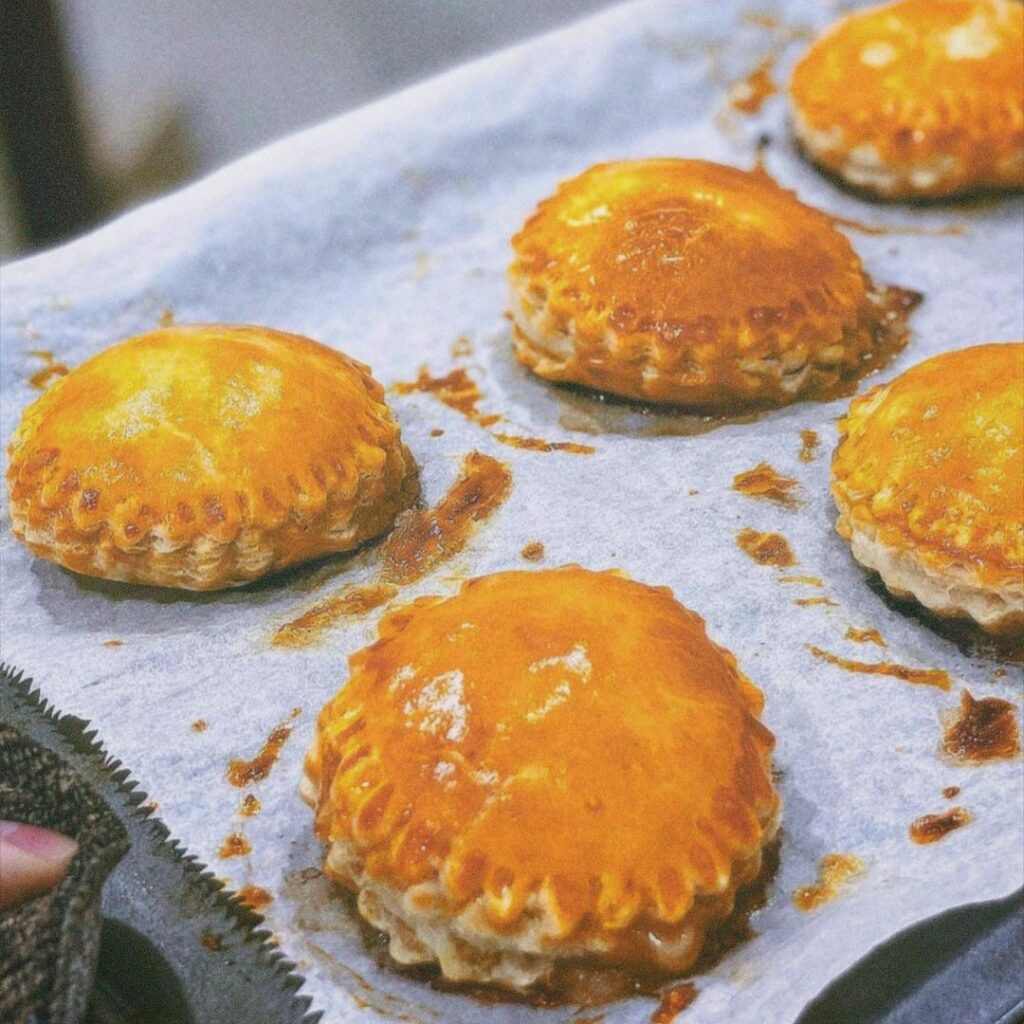
Do you know “where did pate chaud come from“, I will have your answer for this question. Vietnamese pate chaud is a French-inspired pastry that has been adapted to Vietnamese taste preferences. Pate chaud itself is a type of savory or sweet pastry with origins in France, consisting of a flaky crust filled with various ingredients such as meat, vegetables, cheese, or sweet fillings like fruit or custard.
The exact history of pate chaud is unclear, but it is believed to have originated in France during the 18th century. Some sources suggest that it was created as a way to use up leftover ingredients, while others claim that it was invented by French bakers looking to create a portable snack for travelers. Another popular food item from the French colonial era is the banh mi, which is a delicious Vietnamese baguette.
Regardless of its origin, pate chaud has become a beloved pastry in France and other countries around the world, including Vietnam.
Pate chaud recipe
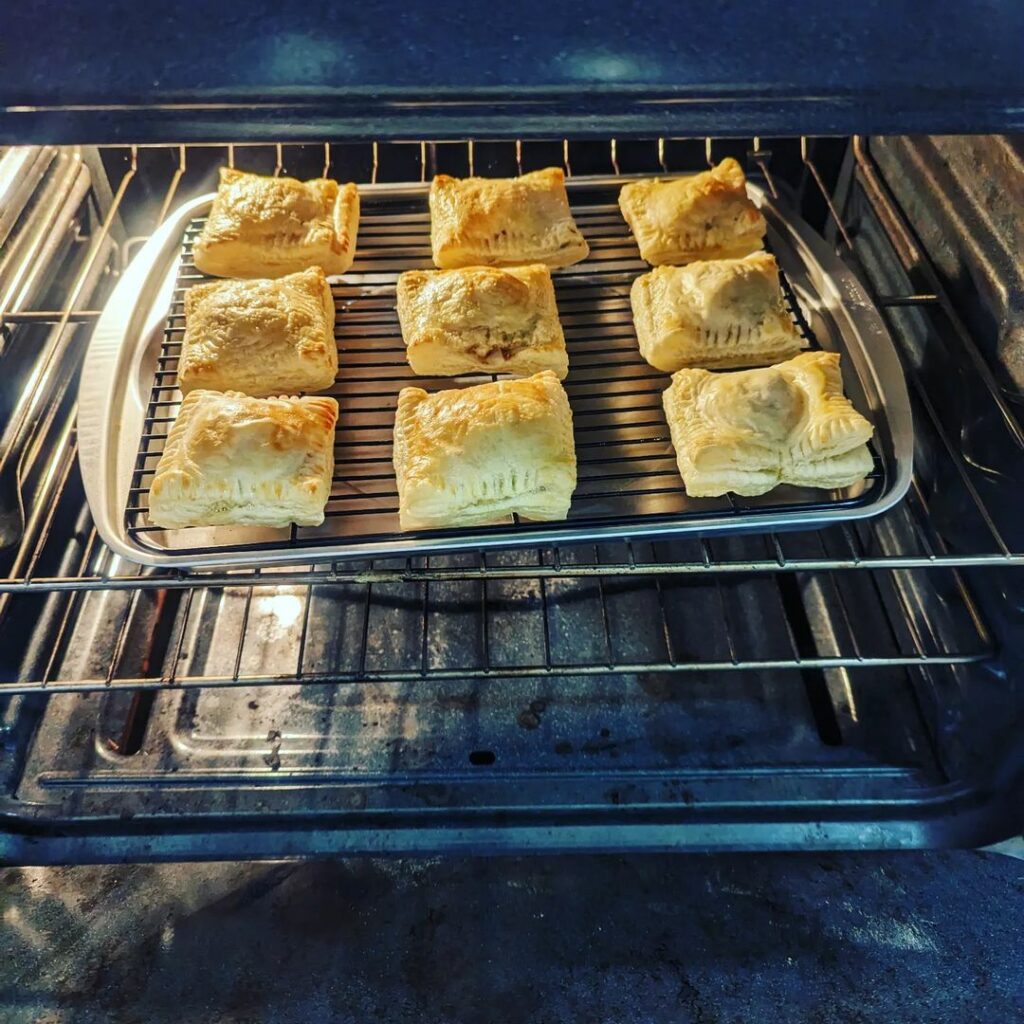
Vietnamese pate chaud recipe makes 12 pate chaud.
Cooking note
- Yield: 12 servings
- Prep Time: 30 minutes
- Cook Time: 25 minutes
- Total Time: 55 minutes
- Course: Snack, Appetizer
- Cuisine: Vietnamese
- Equipment: Baking sheet, mixing bowls, pastry cutter
Pate chaud ingredients
- 2 cups all-purpose flour
- 1/2 teaspoon salt
- 1 cup unsalted butter, cut into small pieces and chilled
- 1/2 cup cold water
- 1 egg, beaten
- 1/2 pound ground pork or beef
- 1 small onion, finely chopped
- 1/2 teaspoon salt
- 1/4 teaspoon black pepper
- 1/4 teaspoon sugar
- 1/4 teaspoon garlic powder
- 1 egg, beaten
How to make pate chaud?
To make Vietnamese pate chaud without burning or problems, you should follow my pate chaud recipes.
- Preheat oven to 375 °F.
- In a large mixing bowl, combine flour, salt, butter, and lard until the mixture resembles coarse crumbs.
- Gradually add ice water, mixing until the dough comes together.
- Knead dough on a floured surface until smooth.
- In a separate bowl, mix together ground pork, shallots, fish sauce, soy sauce, sugar, black pepper, and beaten eggs.
- Roll out dough to 1/8 inch thickness and cut into circles.
- Spoon filling onto each circle, fold over and seal edges with a fork.
- Brush with egg wash and bake for 30–35 minutes or until golden brown.
Table about nutrient facts of pate chaud
Here’s a table showing the nutrient facts of Pate Chaud:
| Nutrient | Amount |
| Calories | 291 |
| Total Fat | 19g |
| Saturated Fat | 8g |
| Cholesterol | 68 mg |
| Sodium | 352 mg |
| Total Carbohydrate | 20g |
| Dietary Fiber | 1g |
| Sugars | 1g |
| Protein | 9g |
Pate chaud contains a moderate amount of calories, pate chaud calories approximately 291 calories per serving. It is also high in fat and sodium, which should be taken into consideration when consuming this pastry.
However, pate chaud can provide some nutritional value, such as protein and fiber, depending on the filling ingredients used. It is important to enjoy pate chaud in moderation as part of a balanced diet, and to be aware of any potential health risks associated with high-fat and high-sodium foods.
Variations of pate chaud
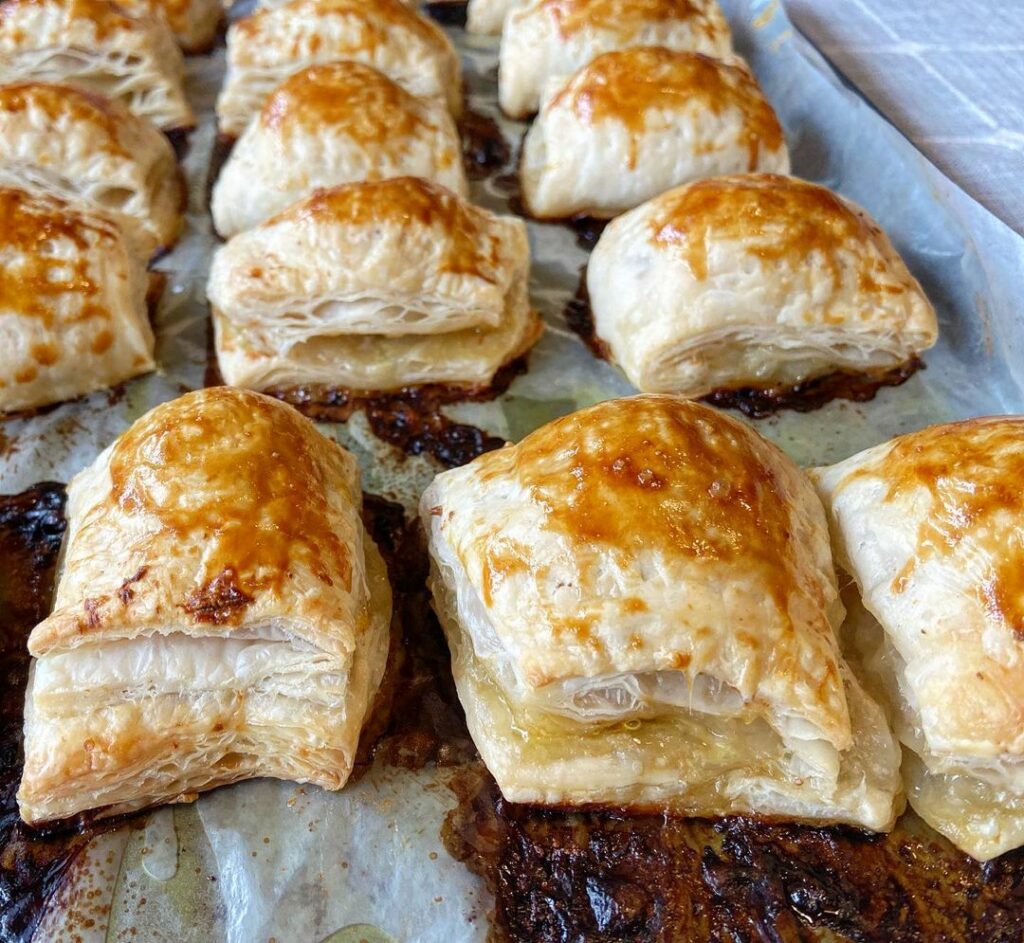
There are several variations of pate chaud, each with its own unique flavor and ingredients. Here are some of the most common variations:
- Vegetarian pate chaud – This version is filled with vegetables like mushrooms, carrots, and peas, often mixed with tofu or a vegetarian protein substitute.
- Seafood pate chaud – This version features seafood as the main filling, often including shrimp, crab, or fish.
- Sweet pate chaud – This variation is filled with sweet ingredients, such as custard, chocolate, or fruit.
- Fusion pate chaud – This variation combines traditional pate chaud ingredients with other cuisines, such as adding Korean bulgogi or Thai green curry as a filling.
The possibilities for pate chaud variations are endless, as fillings can be adapted to suit personal taste preferences.
What to serve with pate chaud?
Pate chaud can be served as a standalone snack or as part of a meal, depending on personal preference. Here are some suggestions on what to serve with pate chaud:
- Dipping Sauces – Pate Chaud pairs well with dipping sauces like sweet chili sauce, soy sauce, or hoisin sauce.
- Soup – Pate Chaud can be served as an appetizer or side dish with soup, such as French onion soup or pho.
- Salad – Pate Chaud can be paired with a light salad, such as a mixed greens’ salad with vinaigrette dressing.
- Beverages – Pate Chaud pairs well with a variety of beverages, including tea, coffee, beer, or wine.
- Charcuterie Board – Pate Chaud can be served as part of a charcuterie board, along with cheeses, meats, crackers, and fruits.
What to serve with pate chaud is a matter of personal preference, so feel free to experiment with different combinations to find what works best for you.
Must Try Banh Mi Pate Recipe At Home
How to store pate chaud?
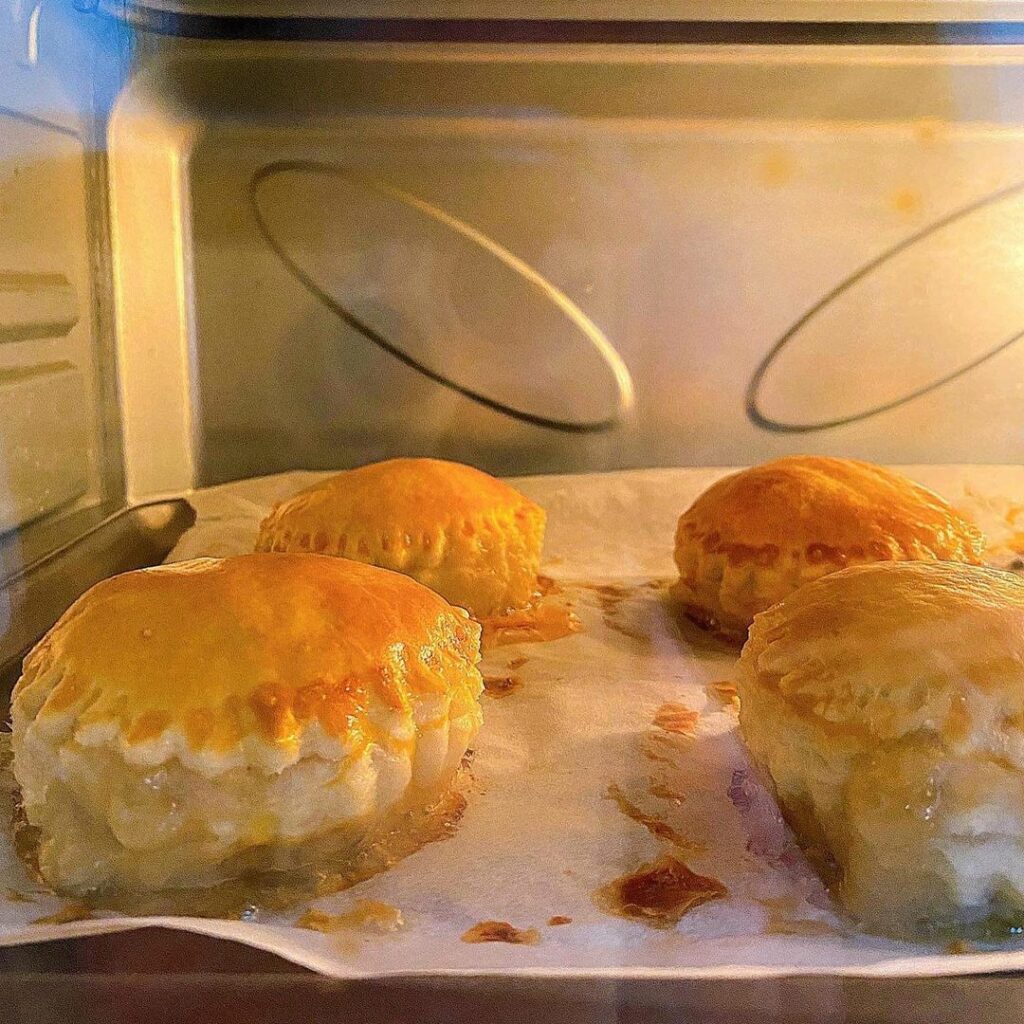
To store Vietnamese pate chaud follow these simple steps:
- Allow the pastries to cool completely to room temperature.
- Place the Pate Chaud in an airtight container or wrap them in plastic wrap.
- Store the pastries in the refrigerator for up to 3–4 days.
If you want to freeze pate chaud for later consumption, follow these additional steps:
- Wrap the pate chaud tightly in plastic wrap and then aluminum foil to prevent freezer burn.
- Label the wrapped pastries with the date and store them in the freezer for up to 2–3 months.
- When you’re ready to eat the frozen pate chaud, remove them from the freezer and let them thaw at room temperature for about an hour. Reheat the pastries in a preheated oven at 350 °F for 10–15 minutes, or until they are heated through.
Common mistakes when making pate chaud
Making pate chaud can be a bit tricky, but with practice and patience, it can be mastered. Here are some common mistakes to avoid when making pate chaud:
- Overworking the dough – Overworking the dough can lead to tough and dry pastries. Be sure to knead the dough only until it comes together and then stop.
- Not chilling the dough – Chilling the dough is essential to achieving a flaky and tender crust. Be sure to chill the dough for at least 30 minutes before rolling it out.
- Overfilling the pastries – Overfilling the pastries can cause them to burst open while baking. Be sure to leave enough room around the edges to seal the pastries properly.
- Not sealing the edges properly – Not sealing the edges properly can cause the pastries to open up while baking. Be sure to crimp the edges of the pastries tightly with a fork.
- Skipping the egg wash – Skipping the egg wash can result in dry and pale pastries. Be sure to brush the pastries with beaten eggs to achieve a golden and shiny crust.
- Baking at the wrong temperature – Baking at the wrong temperature can result in unevenly cooked pastries. Be sure to preheat the oven to the correct temperature before baking.
Tips and tricks to make pate chaud
If you often make mistakes when making pate chaud, I will give you some tips and tricks to make the perfect pate chaud.
- Use could butter and lard – Using cold butter and lard will help to create a flaky crust. Be sure to chill the fats before using them.
- Chill the dough – Chilling the dough before rolling it out will also help to create a flaky crust. Be sure to chill the dough for at least 30 minutes before using it.
- Roll the dough thin – Rolling the dough thin will create a delicate and crispy crust. Be sure to roll the dough to about 1/8 inch thickness.
- Use a sharp knife or cookie cutter – Using a sharp knife or cookie cutter to cut the dough will create clean and even shapes.
- Don’t overfill the pastries – Overfilling the pastries can cause them to burst open while baking. Be sure to leave enough room around the edges to seal the pastries properly.
- Seal the edges tightly – Sealing the edges tightly with a fork will help to prevent the pastries from opening up while baking.
- Use an egg wash – Brushing the pastries with an egg wash will help to create a golden and shiny crust.
- Let the pastries cool – Letting the pastries cool completely before serving will help to set the filling and create a crisp crust.
FAQs
How to say pate chaud?
Pate Chaud is typically pronounced as “pat show” with a French accent.
What is the difference between pate chaud and pate brisee?
Pate chaud and pate brisee are both French pastries, but they have some key differences.
- Pate chaud is a pastry that is filled with a variety of savory or sweet fillings and has a crispy and flaky exterior. The dough for pate chaud is typically made with a combination of butter, lard or shortening, flour, and water. It is rolled out thin, filled with the desired filling, and then baked until golden brown.
- Pate brisee, on the other hand, is a type of pastry dough that is used as a base for tarts and pies. It has a flaky texture, but is not typically filled. The dough for pate brisee is also made with butter, flour, and water, but it does not contain any additional fats like lard or shortening. The dough is also typically sweeter than the dough used for pate chaud.
The main difference between pate chaud and pate brisee is that pate chaud is a filled pastry with a savory or sweet filling, while pate brisee is a pastry dough used as a base for tarts and pies.
Is pate chaud gluten-free?
Pate chaud is typically not gluten-free, as the pastry dough is made with all-purpose flour, which contains gluten. However, it is possible to make a gluten-free version of pate chaud by using gluten-free flour as a substitute for all-purpose flour.
There are many gluten-free flour options available, such as almond flour, rice flour, and coconut flour, that can be used to make a gluten-free pate chaud dough. It is important to note that gluten-free flour may require different amounts of liquid or other ingredients, so it is recommended to use a gluten-free pate chaud recipe or to make adjustments to the recipe accordingly.
Additionally, if you are purchasing pate chaud from a bakery or restaurant, it is best to check with the establishment to see if they offer a gluten-free option.
How long does pate chaud last in the fridge?
Pate Chaud can last in the refrigerator for up to 3-4 days if stored properly in an airtight container or wrapped tightly in plastic wrap. It is important to allow the pastries to cool completely to room temperature before storing them in the refrigerator.
Is pate chaud high in fat?
Pate chaud is a pastry that can be high in fat, as it is typically made with butter or lard, which are high in saturated fat. The amount of fat in pate chaud can vary depending on the filling ingredients used and the recipe.
What beverages pair well with pate chaud?
There are several beverages that pair well with pate chaud, including tea, coffee, beer, or wine. For savory pate chaud, a light red or white wine can be a good choice, while for sweet pate chaud, a sparkling wine or dessert wine can be a good pairing.
Can pate chaud be made with puff pastry?
Pate chaud can be made with puff pastry as a substitute for the traditional pastry dough. Puff pastry can create a lighter and flakier crust, but it can also be more challenging to work with. It is important to follow a recipe specifically designed for puff pastry if using it as a substitute for traditional pate chaud dough.
Is it necessary to use lard in pate chaud dough?
It is not necessary to use lard in pate chaud dough, as other types of fat such as butter or shortening can be used as a substitute. However, some recipes may call for lard, as it can contribute to a flaky and tender crust.
Can pate chaud be made with fruit?
Pate chaud can be made with fruit as a sweet filling. Some popular fruit fillings for pate chaud include apples, peaches, and strawberries. The fruit is usually mixed with sugar and spices to create a sweet and flavorful filling. Sweet pate chaud is often served as a dessert or as a sweet snack.
Conclusion
Finnaly, pate chaud is a delicious French-inspired pastry that has become popular in many countries around the world. With its crispy and flaky crust and a variety of savory or sweet fillings, pate chaud is a versatile and satisfying snack or appetizer. Although it is not a health food, pate chaud can provide some nutritional value depending on the filling ingredients used.
Whether you prefer traditional meat fillings or a sweet and fruity filling, there are many variations of pate chaud to suit all tastes. When making pate chaud, it is important to follow the recipe carefully and to avoid common mistakes such as overworking the dough or overfilling the pastries.
With some practice and patience, anyone can create the perfect pate chaud at home. Overall, pate chaud is a pastry that is well worth trying, whether you’re a fan of French cuisine or simply looking for a delicious snack or appetizer.
EASY PÂTÉ CHAUD (VIETNAMESE MEAT PIES)
Published: Oct 8, 2020 · Modified: Sep 28, 2022 by Kaylie This post may contain affiliate links. As an Amazon Associate I earn from qualifying purchases.
Pâté chaud, or bánh patê sô is a Vietnamese hot pastry pie made with a puff pastry that is buttery and flaky with a delicious ground pork filling. It’s a great snack for your little ones or a savory breakfast to enjoy with your morning cup of joe.
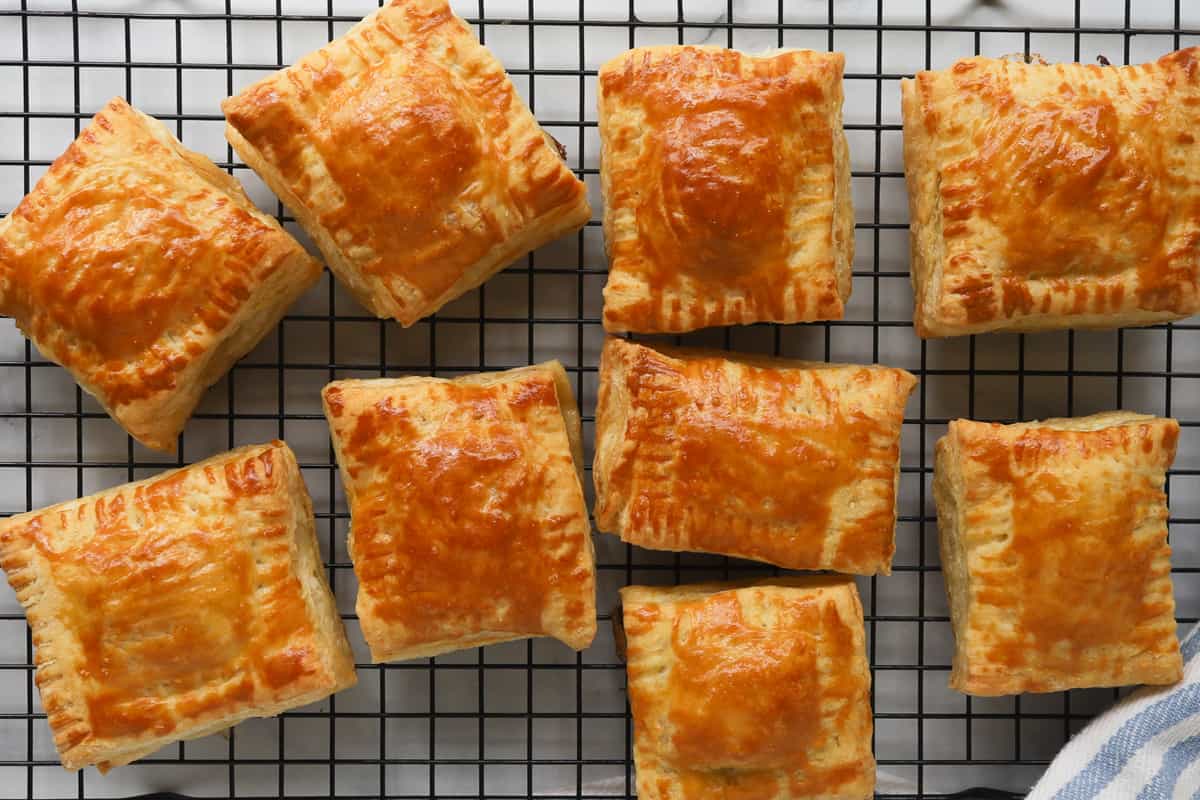
I love baking with pre made puff pastries, try them with my mini chicken pot pie recipe! It is so easy and convenient. In this recipe, I’m using them on these French-inspired Vietnamese meat pies. I’ve eaten pâté chaud since I was a little girl, and naturally, I want to pass on these delicious treats to my boys. There are different variations for the filling and in this recipe, I’ve made it with ground pork for a rich and savory flavor.
If you have never eaten pâté chaud before, this recipe is a must-try. Savory mini meat pies with a nice flaky crust…yum! For busy moms, these are a great portable meal or snack that you can bake in batches and freeze. My boys love them!
Ready to get your French-Vietnamese baking on? Check out my recipe notes below for an easy step-by-step tutorial!Jump to:
INGREDIENTS
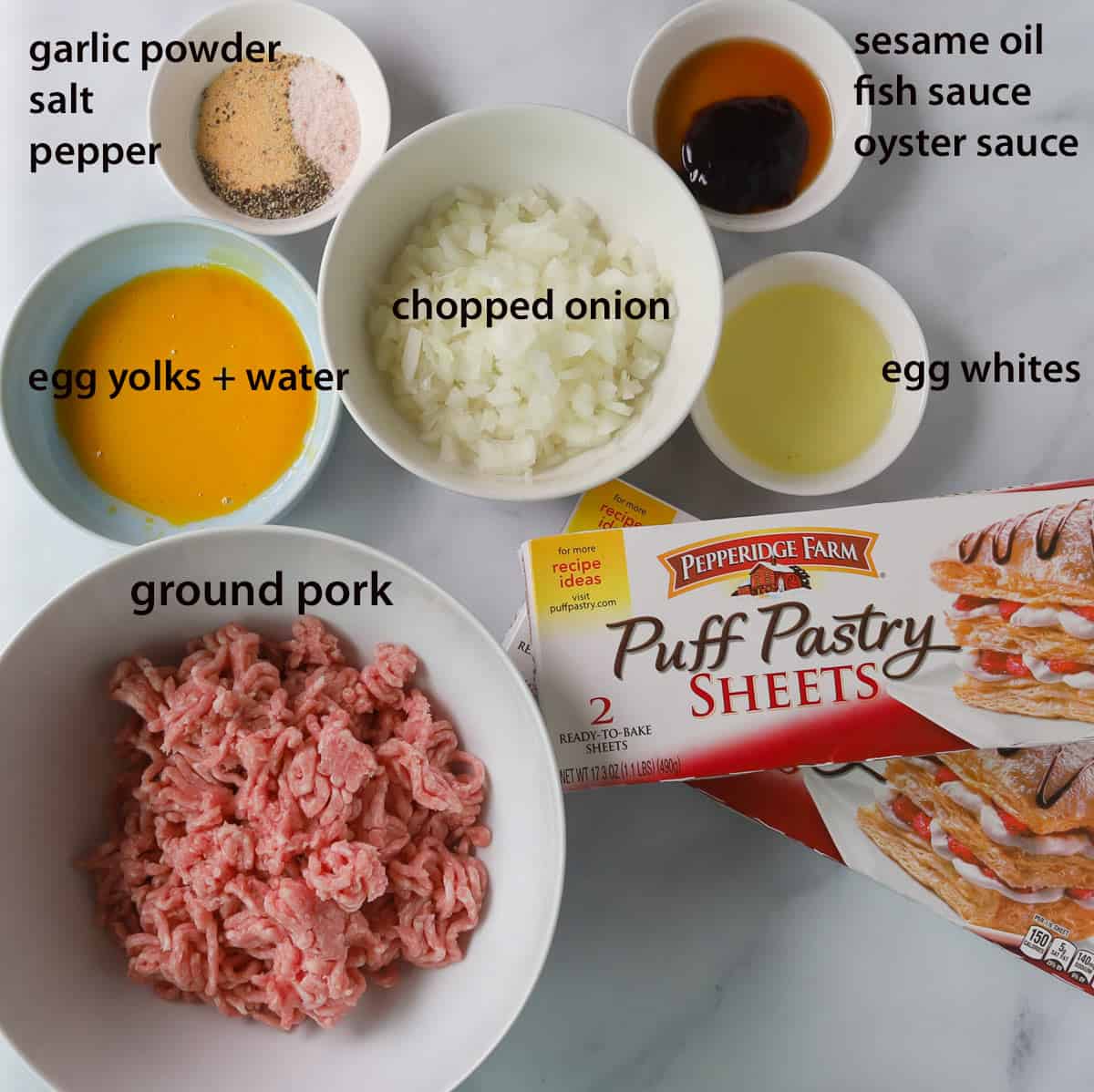
Puff Pastry Dough – You can get these at most major supermarkets. The brand I use is Pepperidge Farm.
Ground Pork -You can also substitute for ground turkey, my sister makes a delicious turkey pâté chaud.
Oyster Sauce – Lee Kum Kee brand is the most popular one, get this at your local Asian store.
Fish Sauce – Red Boat, my favorite fish sauce. You can get this at an Asian store or at most major chain stores in the ethnic aisle.
HOW TO MAKE
Thaw the Dough
Take the dough out of the box and thaw it for at least 30 minutes at room temperature. You want the dough fully thawed, still cold, but not too soft and sticky. This recipe calls for 2 packages – when you’re ready to dive in, chill one package until you’re ready to use it.
Pro Tip: Try to not overwork the dough. If the dough gets too soft, just put it back in the freezer for 5-10 minutes to chill. The colder the dough, the better the rise and flakiness when it bakes.
Make the Filling
Meanwhile, get started on the meat filling. Add onion, oyster sauce, fish sauce, sesame oil, salt and pepper to the pork. Combine well.
Prep the Dough
Line your baking area with parchment paper. This will prevent the dough from sticking.
Lightly roll out the dough, across the seams to make it even.
Cut the dough sheets into 9 even squares. You will see the two seams on the dough when you unfold them. Just cut along those two lines and then cut two more across. You’ll get 18 squares with one box of dough.
Add the Filling
Scoop in about 2 tablespoons of the meat filling and place it in the center of one dough square
Seal the Pocket
Using egg whites, dip with your fingers or use a brush to brush it on all four sides of the pastry square. Then place another square over. Press down on all sides to secure the filling in the middle and to seal the pastry.

Put a Fork on It!
Using the edge of a fork, press lightly to imprint lines on the edges and to further seal the sides.
Add the Egg Wash
When done, brush the top of each pastry with the egg wash. This will give the pâté chaud a beautiful, golden color.
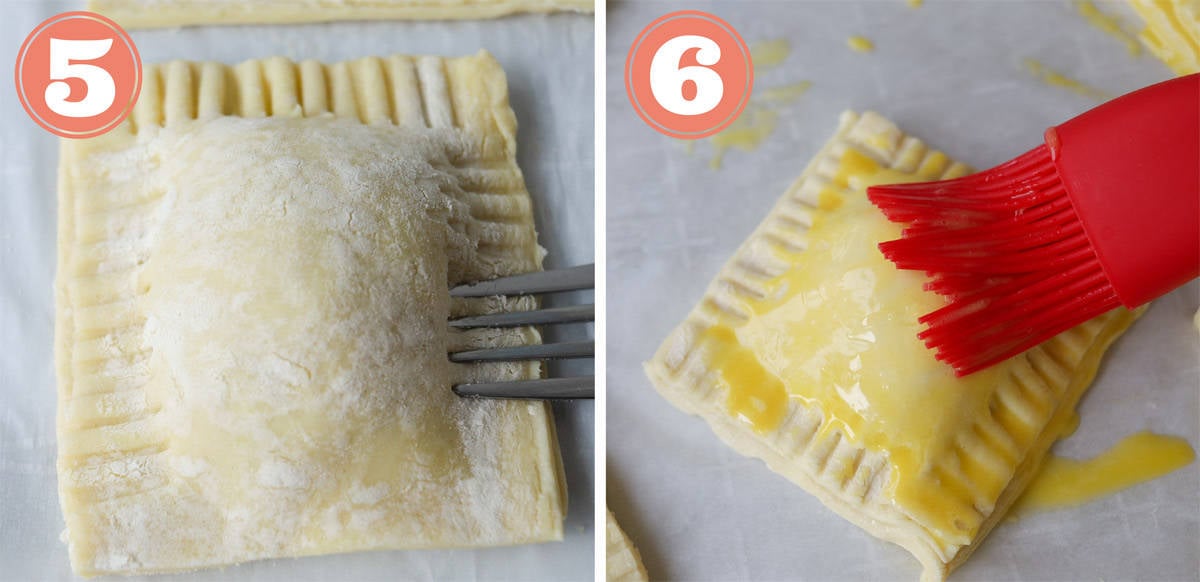
Bake Until Pastry is Puffed and Golden.
Place pastries on a baking pan lined with parchment paper about 1 inch apart and bake for 40 minutes at 350 degrees Fahrenheit.
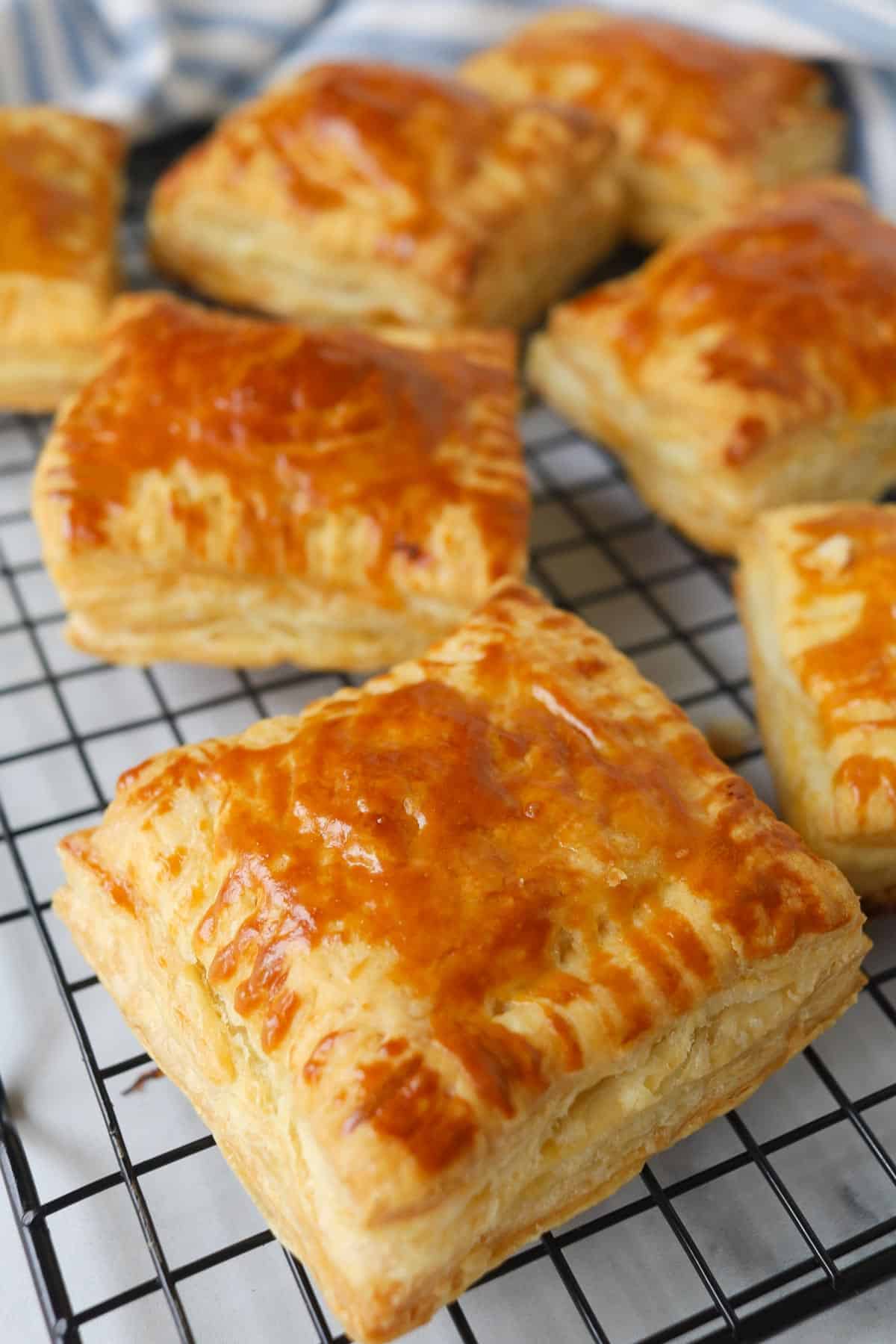
STORING
For the fridge, place the pâté chaud in an airtight container, it’ll keep for 3 days.
To freeze, cool the pâté chaud and place in an airtight container and freeze.
REHEATING
To reheat, bake at 350 degrees Fahrenheit in a toaster oven for about 6-8 minutes. To reheat frozen pâté chaud, thaw them for at least 15 minutes at room temperature and bake at 350 degrees Fahrenheit for 8-10 minutes.
VARIATIONS
You can add vegetables to the filling. Peas and carrots or spinach are great combinations.
Pâté chaud can also be made into round puffs, but I prefer cutting them into even squares. It’s a lot quicker and decreases the amount of time that you have to handle the dough.
You can also cut this recipe in half, which I often do. Just season your meat, split it in half and freeze until you’re ready to make.
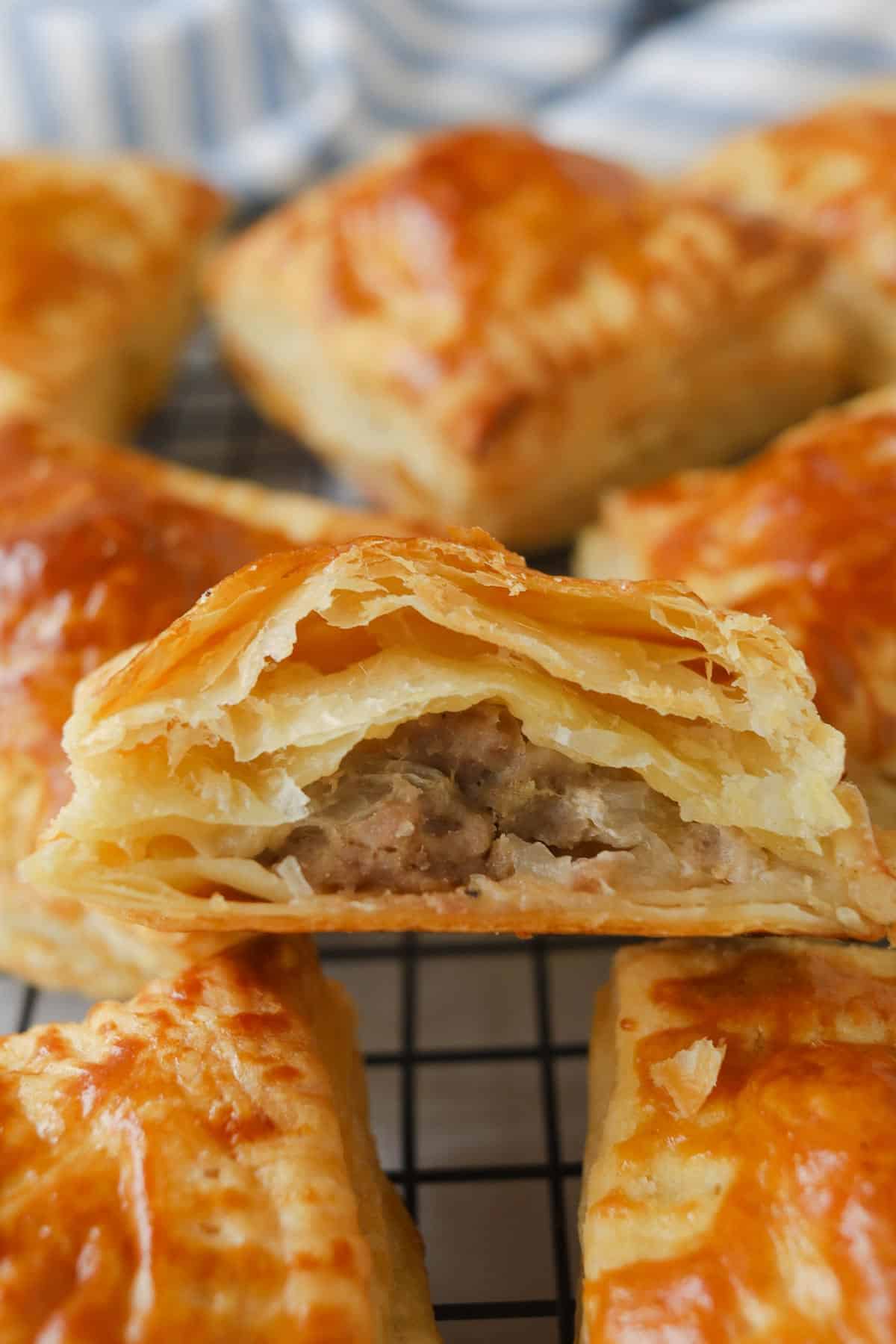
Looking to make other Vietnamese recipes?